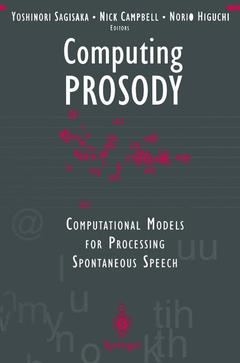Computing PROSODY, Softcover reprint of the original 1st ed. 1997 Computational Models for Processing Spontaneous Speech
Langue : Anglais
Coordonnateurs : Sagisaka Yoshinori, Campbell Nick, Higuchi Norio

This book presents a collection of papers from the Spring 1995 Work shop on Computational Approaches to Processing the Prosody of Spon taneous Speech, hosted by the ATR Interpreting Telecommunications Re search Laboratories in Kyoto, Japan. The workshop brought together lead ing researchers in the fields of speech and signal processing, electrical en gineering, psychology, and linguistics, to discuss aspects of spontaneous speech prosody and to suggest approaches to its computational analysis and modelling. The book is divided into four sections. Part I gives an overview and theoretical background to the nature of spontaneous speech, differentiating it from the lab-speech that has been the focus of so many earlier analyses. Part II focuses on the prosodic features of discourse and the structure of the spoken message, Part ilIon the generation and modelling of prosody for computer speech synthesis. Part IV discusses how prosodic information can be used in the context of automatic speech recognition. Each section of the book starts with an invited overview paper to situate the chapters in the context of current research. We feel that this collection of papers offers interesting insights into the scope and nature of the problems concerned with the computational analysis and modelling of real spontaneous speech, and expect that these works will not only form the basis of further developments in each field but also merge to form an integrated computational model of prosody for a better understanding of human processing of the complex interactions of the speech chain.
Preface.- Contributors.- I The Prosody of Spontaneous Speech.- 1 Introduction to Part I.- 2 A Typology of Spontaneous Speech.- 3 Prosody, Models, and Spontaneous Speech.- 4 On the Analysis of Prosody in Interaction.- II Prosody and the Structure of the Message.- 5 Introduction to Part II.- 6 Integrating Prosodic and Discourse Modelling.- 7 Prosodic Features of Utterances in Task-Oriented Dialogues.- 8 Variation of Accent Prominence within the Phrase: Models and Spontaneous Speech Data.- 9 Predicting the Intonation of Discourse Segments from Examples in Dialogue Speech.- 10 Effects of Focus on Duration and Vowel Formant Frequency in Japanese.- III Prosody in Speech Synthesis.- 11 Introduction to Part III.- 12 Synthesizing Spontaneous Speech.- 13 Modelling Prosody in Spontaneous Speech.- 14 Comparison of F0 Control Rules Derived from Multiple Speech Databases.- 15 Segmental Duration and Speech Timing.- 16 Measuring temporal compensation effect in speech perception.- 17 Prediction of Major Phrase Boundary Location and Pause Insertion Using a Stochastic Context-free Grammar.- IV Prosody in Speech Recognition.- 18 Introduction to Part IV.- 19 A Multi-level Model for Recognition of Intonation Labels.- 20 Training Prosody-Syntax Recognition Models without Prosodic Labels.- 21 Disambiguating Recognition Results by Prosodic Features.- 22 Accent Phrase Segmentation by F0 Clustering Using Superpositional Modelling.- 23 Prosodic Modules for Speech Recognition and Understanding in VERBMOBIL.- Author Index.- Citation Index.
The contributions to this volume represent the state of the art of computational analysis and modelling of spontaneous speech. The book is organized in four main sections. The first gives the theoretical background and discusses how spontaneous speech differs from the laboratory-speech that has been the focus of most earlier analyses. The next part focuses on prosody and the structure of the spoken message, and the third discusses the generation and modelling of prosody for speech synthesis. The concluding part considers the use of prosodic information in automatic speech recognition. Each part begins with an overview of the field , other chapters are based on a workshop on computational approaches to processing spontaneous speech and represent the current state of research.
Ouvrage de 401 p.
15.5x23.5 cm
Date de parution : 04-2011
Ouvrage de 400 p.
Disponible chez l'éditeur (délai d'approvisionnement : 15 jours).
Prix indicatif 117,64 €
Ajouter au panierThèmes de Computing PROSODY :
© 2024 LAVOISIER S.A.S.



